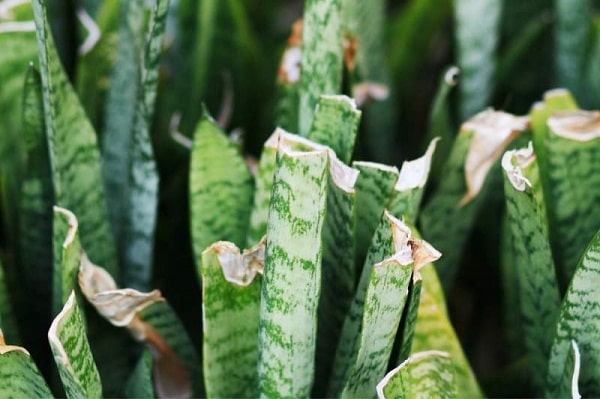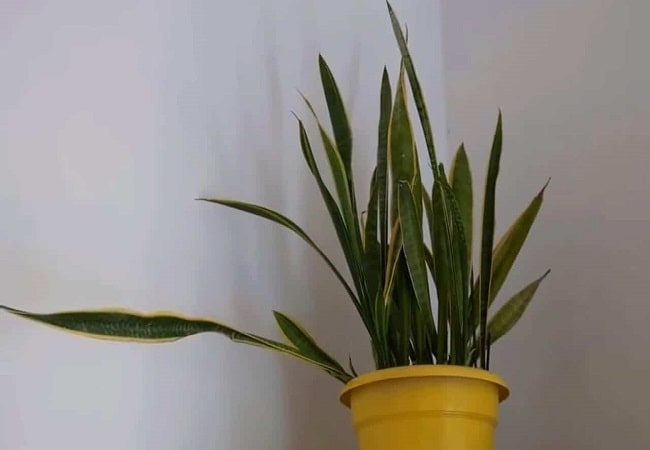Leaves cracking is a physical response that some plants have to environmental stress. The leaves will develop small cracks in the tissue, usually along the veins, as a way to release excess water and prevent the plant from wilting. This process is also known as transpiration.
The snake plant (Sansevieria trifasciata) is a hardy indoor succulent known for its wide, green leaves. Recently, many people have noticed that their snake plants’ leaves are cracking. So, why are snake plant leaves cracking?
In this piece, I’ll talk about the strange occurrence of snake plant leaves that crack and offer some tips for avoidance. Stay tuned to find out more.
Quick Navigation
The Symptoms Of A Cracked Snake Plant Leaf

A cracked snake plant leaf may have some of the following symptoms:
- Cracks that go through the leaf completely
- Brown or black spots on the leaves
- Wilting or drooping of the leaves
- Yellowing of the leaves
- The plant might not become as tall or yield as many flowers or leaves as usual.
It is best to immediately act and remove the leaf if you notice any of these signs.
The Possible Causes Of Snake Plant Leave Cracking

When snake plant leaves start to crack and peel, it can signify something wrong with the plant. Ten of the most typical reasons for snake plant leaf cracking are listed below:
1. Overwatering: When a plant is overwatered, the roots can’t get enough water, sending water up through the stem and leaves. Overwatering can cause soft tissues in the leaves to break down.
2. Low light: Low light can lead to weaker plants and slower growth, leading to overwatering or overwatering.
3. Fungal infection: Fungal infections cause spores to grow between cells in the leaf tissue, resulting in leaf cracking.
4. Root problems: Poor root systems can cause plants to overwater or get too much fertilizer, leading to fungal infection or root rot.
5. Plant disease: Plant diseases are caused by viruses, bacteria, or fungi, and they damage plants cell walls, leading to leaf cracking and other symptoms of disease in the plant.
6. Heat stress: Exposure to high temperatures (above 90 degrees Fahrenheit) for an extended period can cause plants to break down their leaves.
7. Poor soil: Poor soil can contain too much water or poorly drained water, which can lead to overwatering, root problems, and fungal infection.
8. Lack of nutrients: Nutrients are necessary for healthy plant growth, and leaf cracking can signify a lack of nutrients in the soil.
9. Chemical exposure: Chemicals toxic to plants can cause leaf cracking, including herbicides, fungicides, and pesticides.
10. Genetic problems: It is only possible to replant the plant if the issue is severe because some plants are genetically predisposed to leaf cracking.
11. Lac of humidity: Moisture retention can be the culprit in snake plant leaves cracking. When humidity is too high, it causes the leaves to expand and crack because of the water retention. Aim for a humidity level of 50-70% to prevent this.
The Prevention Tips For Snake Plant’s Leaves From Cracking

If you have one in your home, you may have observed that a snake plant’s leaves occasionally crack. Even though it’s not always a sign of trouble, this is something to be aware of and keep in mind as you look after your plant. Here are some tips to prevent cracks from happening in the first place:
1. Keep your snake plant well-watered and fertilized: During high humidity, give them a good fertilizer and plenty of water each month. By doing this, you can keep the plant healthy and avoid any issues with cracked leaves.
2. Avoid over-pruning: If you want to keep your snake plant compact, don’t go overboard with pruning! Over pruning can lead to excess growth, creating stresses on the plant’s roots and causing cracks in the leaves. Instead, focus on keeping the plants neat without going too far; this will make it easier to care for them overall!
3. Watch out for pests: Bugs like aphids love to infest plants, including snakes. Spray plants with neem oil or another natural insecticide as soon as you notice aphids or other bugs destroying them. Doing this can help kill the pests and stop them from further harming your plant.
4. Keep your snake plant in an area with good air circulation: The leaves will be preserved from drying out and kept healthy. If you reside in a humid environment, try to situate your snake plant in an area with good airflow or install a fan nearby to help move the air.
5. Get help from a professional: Get professional assistance if you find that the leaves on your snake plant are cracking more and more. A qualified horticulturist can inspect your plant and give tips on properly caring for it.
Frequently Asked Questions
Why Are The Leaves On My Snake Plant Splitting?
The leaves on your snake plant may be splitting due to tip burn. Tip burn is a common problem caused by over-fertilization or applying fertilizer at the wrong time. The leaves may also be splitting because of dehydration. Make sure you are watering your plant adequately and avoid over-watering it.
Should I Trim Damaged Snake Plant Leaves?
Trimming any damaged leaves from snake plants is crucial because they can affect the plant’s general health. The entire plant may need to be trimmed if numerous leaves have significant damage. Use razor-sharp scissors or clippers to trim the plant to prevent further harm.
What Does An Underwatered Snake Plant Look Like?
An underwatered snake plant typically has a drooping appearance, with its leaves looking limp and wilted. The leaves may even turn brown and die if the plant is not watered for an extended period.
How Do You Rejuvenate A Snake Plant?
One can easily revive a snake plant by following a few straightforward steps. Use a pair of sharp scissors first to remove any leaves that are dead or dying from the plant. Remove the plant from the water after 10 to 15 minutes, and let it air dry.
Should I Mist My Snake Plant?
Lack of water is most likely the cause of the plant’s problems. It is recommended to mist plants regularly, especially those kept in a pot or container. When misting, use room-temperature water and avoid getting the leaves wet.
In The End
Snake plant leaves that begin to peel and crack may indicate a problem with the plant. Excessive watering, poor lighting, fungal infections, root problems, plant diseases, heat stress, poor soil, nutrient shortages, chemical exposure, and genetic problems are a few of the most frequent causes of snake plant leaf cracking. Consult a specialist for assistance if you see that your snake plant is having trouble and leaf cracking is becoming an issue.

Plants are my life. I’m a plant whisperer and an amateur gardener who loves to share gardening tips and tricks with you!


